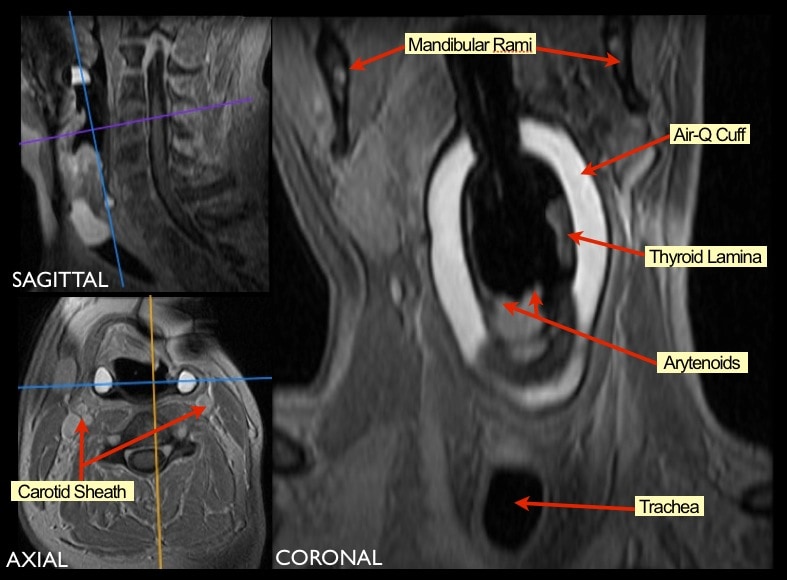There was a lot of talk about this paper when it was first published. And rightly so – it raised an important question on the use of supra-glottic airways in cardiac arrest. (SGAs)
I first found it at ScanCrit and then EMCrit talked about it. As did Minh.
I even got all worked up and did a video on it myself:
I didn’t buy it. I figured the anatomy just didn’t fit.
And then…
I got an email from this guy.

This letter to the editor in Resuscitation is the result of that conversation. We originally had it planned as a short paper with more images and a bigger discussion but it got rejected in that form so we shortened it down.
But of course in the spirit of #FOAMed it wouldn’t do to just leave it at the letter so here’s a slightly fuller more in depth discussion with some colour images and some video.
Would love to hear any thoughts you have.
Andy and Jim.
—
Jim had the fortune of acquiring some MR images of the Air-Q SGA (below) in a live patient with some gadolinium in the cuff. This allowed some wonderful images showing the placement and disruption of normal anatomy in the pharynx. Both the Air-Q cuff and the ETT cuff were filled with gadolinium.

I’ve added some videos in different planes so you can scroll through yourself and see what you think.
httpv://vimeo.com/49372505
httpv://vimeo.com/49372906
httpv://vimeo.com/49373123
Conclusions
It’s remarkable that there’s not really any images out there. A PubMed search revealed lots of studies looking at MR compatibility and that but no actual imaging in patients. We (and a friendly radiologist) examined the images and pulled out some key points.
- the cuff lies anteror medial to the carotid sheath in normal placement
- distension of the cuff will move the SGA out laterally and anteriorly
- the hyoid bone seems to afford some protection from the cuff
- the flaccid pharyngeal constrictors are markedly distorted by the cuff demonstrated in the asymmetry in the images.
- there was no loss of calibre in the images that we could see
We initially wrote this up as a short paper for Resuscitation but it was initially rejected. It has just been published as a letter to the editor. The text of the short paper can be found in the embedded GDoc below.
This makes me a little more at ease, knowing that at least theoretically the SGAs shouldn’t cause significant distortion of the anatomy. You can hear Jim and I talking more about this on Minh’s Podcast.
UPDATE October 2012
Jim brought this paper to my attention which is a great study looking at the LMA Supreme and the i-Gel in healthy volunteers using MR imaging.
They have multiple subjects, and despite not addressing the specific question of compression of the caroitds it does back up the idea that the main force pushes the larynx anteriorly and doesn’t occlude the vessels.
Be sure and check it out.




Truly brilliant stuff Andy – the podcast and this post! Haven’t read the paper yet, can’t access the full text!
Andy!
We should discuss this new article [Magnetic resonance imaging study of the in vivo position of the extraglottic airway devices i-gelTM and LMA-SupremeTM in anaesthetized human volunteers].
We beat them to publication by the way. I am interested in some specific details they observed, such as how they observed that both the LMA Supreme and iGel reduced the area of the glottic aperture (p<0.001). This what I call the "handshake" that the SGA makes with the hypopharynx. I have seen this phenomena (fiber optically) in the Air-Q if it is placed too deeply–the cure is to withdraw it/readjust it.
Pingback: The LITFL Review 076